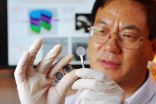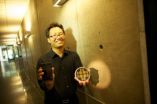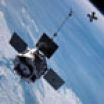(Press-News.org) Researchers have developed a self-charging power cell that directly converts mechanical energy to chemical energy, storing the power until it is released as electrical current. By eliminating the need to convert mechanical energy to electrical energy for charging a battery, the new hybrid generator-storage cell utilizes mechanical energy more efficiently than systems using separate generators and batteries.
At the heart of the self-charging power cell is a piezoelectric membrane that drives lithium ions from one side of the cell to the other when the membrane is deformed by mechanical stress. The lithium ions driven through the polarized membrane by the piezoelectric potential are directly stored as chemical energy using an electrochemical process.
By harnessing a compressive force, such as a shoe heel hitting the pavement from a person walking, the power cell generates enough current to power a small calculator. A hybrid power cell the size of a conventional coin battery can power small electronic devices – and could have military applications for soldiers who might one day recharge battery-powered equipment as they walked.
"People are accustomed to considering electrical generation and storage as two separate operations done in two separate units," said Zhong Lin Wang, a Regents professor in the School of Materials Science and Engineering at the Georgia Institute of Technology. "We have put them together in a single hybrid unit to create a self-charging power cell, demonstrating a new technique for charge conversion and storage in one integrated unit."
The research was reported Aug. 9, 2012 in the journal Nano Letters. The research was supported by the Defense Advanced Research Projects Agency (DARPA), the U.S. Air Force, the U.S. Department of Energy, the National Science Foundation, and the Knowledge Innovation Program of the Chinese Academy of Sciences.
The power cell consists of a cathode made from lithium-cobalt oxide (LiCoO2) and an anode consisting of titanium dioxide (TiO2) nanotubes grown atop a titanium film. The two electrodes are separated by a membrane made from poly(vinylidene fluoride) (PVDF) film, which generates a piezoelectric charge when placed under strain. When the power cell is mechanically compressed, the PVDF film generates a piezoelectric potential that serves as a charge pump to drive the lithium ions from the cathode side to the anode side. The energy is then stored in the anode as lithium-titanium oxide.
Charging occurs in cycles with the compression of the power cell creating a piezopotential that drives the migration of lithium ions until a point at which the chemical equilibriums of the two electrodes are re-established and the distribution of lithium ions can balance the piezoelectric fields in the PVDF film. When the force applied to the power cell is released, the piezoelectric field in the PVDF disappears, and the lithium ions are kept at the anode through a chemical process.
The charging cycle is completed through an electrochemical process that oxidizes a small amount of lithium-cobalt oxide at the cathode to Li1-xCoO2 and reduces a small amount of titanium dioxide to LixTiO2 at the anode. Compressing the power cell again repeats the cycle.
When an electrical load is connected between the anode and cathode, electrons flow to the load, and the lithium ions within the cell flow back from the anode side to the cathode side.
Using a mechanical compressive force with a frequency of 2.3 Hertz, the researchers increased the voltage in the power cell from 327 to 395 millivolts in just four minutes. The device was then discharged back to its original voltage with a current of one milliamp for about two minutes. The researchers estimated the stored electric capacity of the power cell to be approximately 0.036 milliamp-hours.
So far, Wang and his research team – which included Xinyu Xue, Sihong Wang, Wenxi Guo and Yan Zhang – have built and tested more than 500 of the power cells. Wang estimates that the generator-storage cell will be as much as five times more efficient at converting mechanical energy to chemical energy for as a two-cell generator-storage system.
Much of the mechanical energy applied to the cells is now consumed in deforming the stainless steel case the researchers are using to house their power cell. Wang believes the power storage could be boosted by using an improved case.
"When we improve the packaging materials, we anticipate improving the overall efficiency," he said. "The amount of energy actually going into the cell is relatively small at this stage because so much of it is consumed by the shell."
Beyond the efficiencies that come from directly converting mechanical energy to chemical energy, the power cell could also reduce weight and space required by separate generators and batteries. The mechanical energy could come from walking, the tires of a vehicle hitting the pavement, or by harnessing ocean waves or mechanical vibrations.
"One day we could have a power package ready to use that takes advantage of this hybrid approach," Wang said. "Almost anything that involves mechanical action could provide the strain needed for charging. People walking could be generating electricity as they move."
INFORMATION:
This research was supported by DARPA (HR0011-09-C-0142); the U.S. Air Force, the U.S. Department of Energy, Office of Basic Energy Sciences (DE-FG02-07ER46394), the National Science Foundation (CMMI-0403671), and the Knowledge Innovation Program of the Chinese Academy of Sciences (KJCX2-YW-M13). The content is solely the responsibility of the authors and does not necessarily represent the official views of DARPA, the U.S. Air Force, the Department of Energy or the National Science Foundation.
Citation: Xinyu Xue, Sihong Wang, Wenxi Guo, Yan Zhang and Zhong Lin Wang, Hybridizing Energy Conversion and Storage in a Mechanical-to-Electrochemical Process for Self-Charging Power Cell, Nano Letters. DOI: 10.1021/nl302879t
Self-charging power cell converts and stores energy in a single unit
2012-08-22
ELSE PRESS RELEASES FROM THIS DATE:
NASA satellites see 2 intensifying northwestern Pacific tropical cyclones
2012-08-22
There's double trouble in the northwestern Pacific Ocean in the form of Typhoon Tembin and Tropical Storm Bolaven. NASA's Terra and Aqua satellites teamed up to provide a look at both storms in one view.
The Moderate Resolution Imaging Spectroradiometer (MODIS) instrument flies onboard NASA's Aqua and Terra satellites and the MODIS instrument on each captured a storm when both satellites flew over them on August 21 after midnight (Eastern Daylight Time). The two MODIS images which featured Bolaven and Tembin over the Philippine Sea were combined by NASA's MODIS Rapid ...
Many options, good outcomes, for early-stage follicular lymphoma
2012-08-22
A University of Rochester Medical Center study published in the Journal of Clinical Oncology, challenges treatment guidelines for early stage follicular lymphoma, concluding that six different therapies can bring a remission, particularly if the patient is carefully examined and staged at diagnosis.
The research underlines the fact that when cancer strikes, modern patients and their oncologists across the United States are taking many diverse treatment paths when there is scant data to support one method over another. This study suggests that the old standard approach ...
Sanctuary chimps show high rates of drug-resistant staph
2012-08-22
Chimpanzees from African sanctuaries carry drug-resistant, human-associated strains of the bacteria Staphlyococcus aureus, a pathogen that the infected chimpanzees could spread to endangered wild ape populations if they were reintroduced to their natural habitat, a new study shows.
The study by veterinarians, microbiologists and ecologists was the first to apply the same modern sequencing technology of bacterial genomes used in hospitals to track the transmission of staph from humans to African wildlife. The results were published Aug. 21 by the American Journal of Primatology.
Drug-resistant ...
'Electronic nose' prototype developed
2012-08-22
RIVERSIDE, Calif. (www.ucr.edu) — Research by Nosang Myung, a professor at the University of California, Riverside, Bourns College of Engineering, has enabled a Riverside company to develop an "electronic nose" prototype that can detect small quantities of harmful airborne substances.
Nano Engineered Applications, Inc., an Innovation Economy Corporation company, has completed the prototype which is based on intellectual property exclusively licensed from the University of California. The device has potential applications in agriculture (detecting pesticide levels), industrial ...
Low oxygen levels may decrease life-saving protein in spinal muscular atrophy
2012-08-22
Investigators at Nationwide Children's Hospital may have discovered a biological explanation for why low levels of oxygen advance spinal muscular atrophy (SMA) symptoms and why breathing treatments help SMA patients live longer. The findings appear in Human Molecular Genetics.*
SMA is a progressive neurodegenerative disease that causes muscle damage and weakness leading to death. Respiratory support is one of the most common treatment options for severe SMA patients since respiratory deficiencies increase as the disease progresses. Clinicians have found that successful ...
Compounds shown to thwart stubborn pathogen's social propensity
2012-08-22
MADISON – Acinetobacter baumanni, a pathogenic bacterium that is a poster child of deadly hospital acquired infections, is one tough customer.
It resists most antibiotics, is seemingly immune to disinfectants, and can survive desiccation with ease. Indeed, the prevalence with which it infects soldiers wounded in Iraq earned it the nickname "Iraqibacter."
In the United States, it is the bane of hospitals, opportunistically infecting patients through open wounds, catheters and breathing tubes. Some estimates suggest it kills tens of thousands of people annually.
But ...
ORNL technology moves scientists closer to extracting uranium from seawater
2012-08-22
Fueling nuclear reactors with uranium harvested from the ocean could become more feasible because of a material developed by a team led by the Department of Energy's Oak Ridge National Laboratory.
The combination of ORNL's high-capacity reusable adsorbents and a Florida company's high-surface-area polyethylene fibers creates a material that can rapidly, selectively and economically extract valuable and precious dissolved metals from water. The material, HiCap, vastly outperforms today's best adsorbents, which perform surface retention of solid or gas molecules, atoms ...
UI instruments aboard twin NASA spacecraft set for launch Aug. 24
2012-08-22
On Aug. 24, NASA will launch two identical satellites from Cape Canaveral, Fla., to begin its Radiation Belt Storm Probes (RBSP) mission to study the extremes of space weather and help scientists improve space weather forecasts.
Why should you care?
Because, says a University of Iowa space physics researcher, if you've ever used a cell phone, traveled by plane, or stayed up late to catch a glimpse of the northern lights, then you have been affected by space weather without even knowing about it.
Scientists want to better understand how the Van Allen radiation belts—named ...
Menopause evolved to prevent competition between in-laws
2012-08-22
The menopause evolved, in part, to prevent competition between a mother and her new daughter-in-law, according to research published today (23 August 2012) in the journal Ecology Letters.
The study – by researchers from the University of Turku (Finland), University of Exeter (UK), University of Sheffield (UK) and Stanford University (US) – explains for the first time why the relationship women had with their daughter-in-laws could have played a key role.
The data showed that a grandmother having a baby later in life, and at the same time as her daughter-in-law, resulted ...
Moffitt Cancer Center melanoma expert reviews unique adverse events with newly approved drug
2012-08-22
An internationally recognized melanoma researcher at Moffitt Cancer Center and colleagues at the University of Kiel in Germany, including Axel Hauschild, M.D. and Katharina C. Kähler, M.D., have published an article in the current issue of The Journal of Clinical Oncology that describes immune-related adverse events for patients receiving either tremelimumab or ipilimumab, the latter a drug approved last year by the U.S. Food and Drug Administration for treating metastatic melanoma and other cancers.
Both drugs are anti-CTLA-antibodies with similar mechanisms of action, ...



